|
Report from
Europe
UK tropical wood product imports down 45%
The import value of tropical wood and wooden furniture into the
UK in the first four months of this year was US$314 million, 45% less
than the same period last year. In quantity terms, the UK imported
132,000 tonnes of tropical wood and wood furniture in the January to
April period, 26% less than the same period last year. The sharp decline
was expected as trade in the opening months of last year was at the
highest level (in dollar terms) since before the 2008 financial crises
and had already slowed markedly since summer 2022.
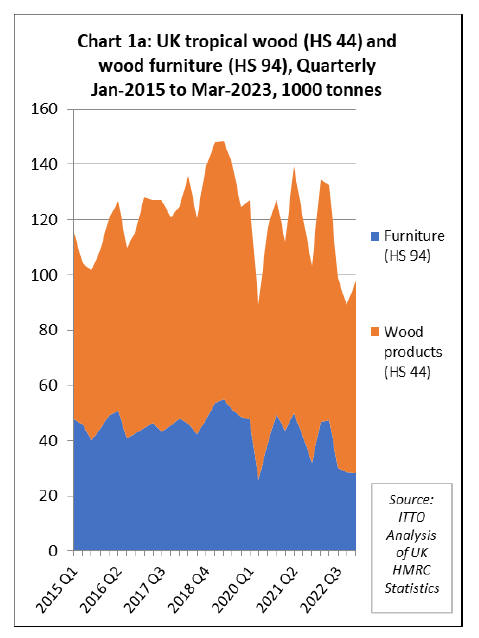
Considering the quarterly trend, the UK imported 98,000 tonnes of tropical
wood and wooden furniture in the first quarter of 2023. Although a 10%
gain compared to the previous quarter, it was the third lowest quarterly
import quantity since before the 2008 financial crises. In the last
decade, trade has only once dipped below the current level, in the
second quarter of 2020 during the first COVID lockdown (Chart 1a above).
The dip in UK imports of tropical wood and wood furniture products since
the middle of last year is part of a wider fall in trade. The total
value of UK imports of all wood and wood furniture products from all
regions was US$3.34 billion in the first four months of 2023, 29% less
than the same period in 2022.
Despite the recent sharp fall in UK trade in wood and wood furniture
products and the added obstacles to UK transactions with EU countries
since Brexit, the value of UK trade with the EU so far this year remains
higher than before the COVID pandemic. However, imports from all other
regions have been significantly lower than before the pandemic (Chart
1b).
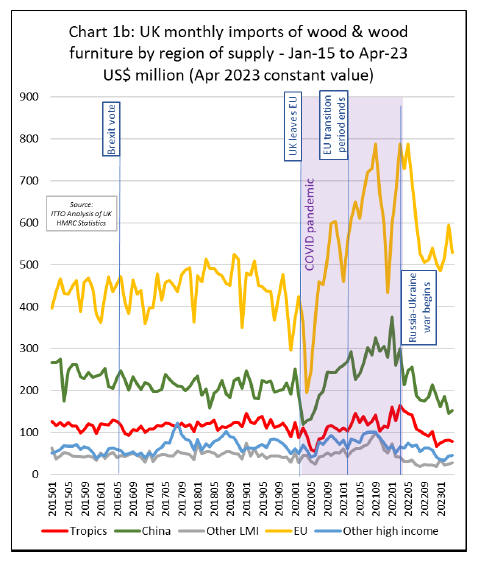
UK hardwood market slow in the face of consumer “hangover”
The UK hardwood market this year is considerably slower than
the last two years, now that the COVID home improvement boom is well and
truly over. British consumers are suffering from a “hangover” with
annual inflation still close to 8% and the bank base rate having been
pushed up to 4.5% following 12 consecutive increases since December
2021.
High stocks of hardwood products were built up in the first half of last
year when prices were higher and have only been selling slowly, often at
a loss to maintain cash flow.
Nevertheless, there are emerging signs of market stabilisation, with
some gaps beginning to open in UK stocks and some more positive economic
signals. The UK consumer confidence index, while still negative, has
risen from record lows recorded at the end of last year.
Inflation is now widely forecast to fall sharply, for example PwC expect
it to level out around 3% to 4% before the end of this year.
The S&P Global/CIPS UK Construction Purchasing Managers’ Index (PMI)
registered 51.6 in May, up from 51.1 in April and above the neutral 50.0
mark for the fourth successive month. Although indicative of only modest
growth, the latest reading pointed to “the strongest upturn in total
construction activity since February.” Commercial building (index at
54.2) was the best-performing segment, with output rising at a “robust
and accelerated pace.”
However, worries about the impact of higher interest rates and subdued
market conditions continued to dampen housing activity in May. Work on
residential building projects decreased for the sixth month running and
at the steepest pace since May 2020. Aside from the pandemic-related
downturn, the latest reading for this category of construction activity
(42.7) was reported by S&P Global/CIPS as being “the lowest for just
over 14 years.”
At a macro-economic level, in May the IMF updated their forecast for UK
GDP growth this year to 0.4%, whereas in April it forecast the economy
would contract by 0.3% in 2023. According to IMF, growth would be helped
by "resilient demand", easing concerns about Brexit, and falling energy
prices.
The IMF said faster-than-usual pay growth and global supply chains
returning to normal after the pandemic had also contributed to its
growth upgrade. However, the IMF also noted that the outlook for UK
growth "remains subdued" and forecast the economy will grow by only 1%
in 2024, rising to 2% in 2025 and 2026.
UK imports of tropical wooden furniture fall sharply
The UK imported US$140 million of tropical wood furniture
products in the first four months of 2023, which is 54% less than the
same period last year. In quantity terms, wood furniture imports were
37,100 tonnes during the four- month period, 40% less than the same
period last year.
In the first four months of 2023 compared to last year, UK import value
of wood furniture from Vietnam was down 48% to US$76 million, Malaysia
was down 48% to US$28 million, India was down 62% to US$14 million,
Indonesia was down 57% to US$13 million, Thailand was down 46% to US$4
million, and Singapore was down 85% to US$3 million. (Chart 2).
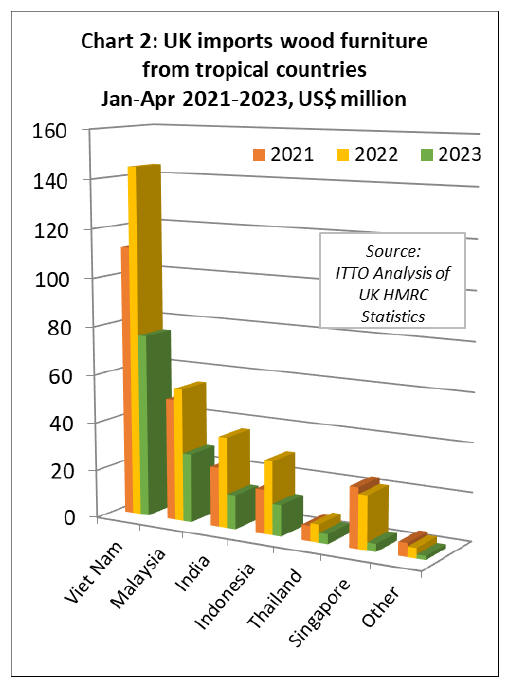
UK imports down for all tropical wood products
Total UK import value of all tropical wood products in Chapter
44 of the Harmonised System (HS) of product codes was US$314 million
between January and April this year, 45% less than the same period in
2022. In quantity terms imports decreased 18% to 95,200 tonnes during
the period.

Compared to the first four months of 2022, UK import value of tropical
joinery products decreased 41% to US$66 million, import value of
tropical plywood decreased 36% to US$42 million, import value of
tropical sawnwood decreased 19% to US$37 million, and import value of
tropical mouldings/decking decreased 36% to US$8 million (Chart 3
above).
UK import value of joinery products from Indonesia (mainly doors) was
US$34 million in the first four months of 2023, down 44% compared to the
same period last year.
UK import value of joinery products from Malaysia and Vietnam (mainly
laminated products for kitchen and window applications) fell
respectively 41% to US$9 million and 52% to US$2 million during the same
period.
UK import value of Chinese tropical joinery products, nearly all
comprising doors, was US$11 million in the January to April period, 36%
less than the same period last year.
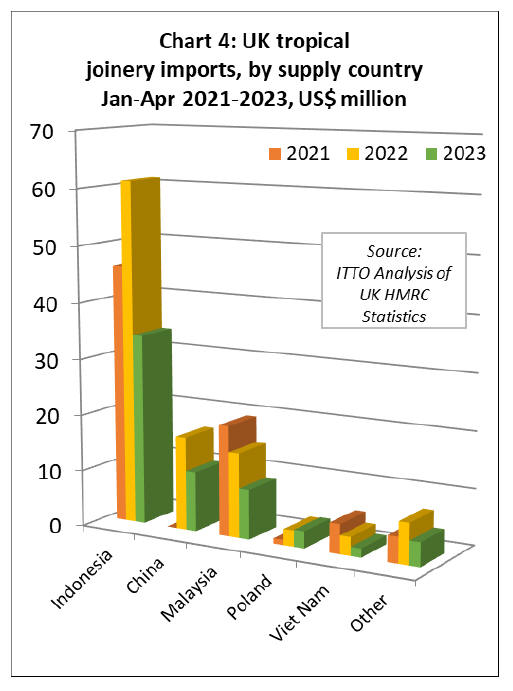
Direct imports of tropical hardwood plywood offset by rise from
China
In the first four months of 2023, the UK imported 75,600 cu.m
of tropical hardwood plywood, 9% less than the same period last year,
with a significant decline in direct imports from tropical countries
partly offset by a rise in imports from China (Chart 5).
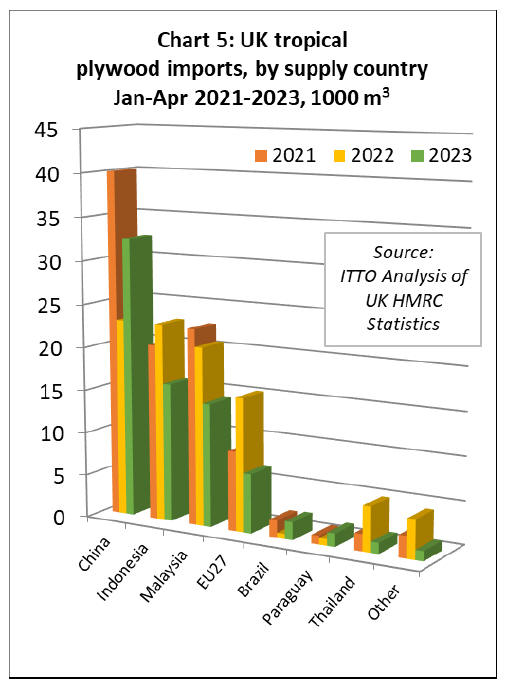
The UK imported 32,400 cu.m of tropical hardwood plywood from China in the
first four months of 2023, 42% more than the same period last year. Last
year, UK imports of Chinese products faced with tropical hardwoods fell
sharply in favour of Chinese products faced with temperate hardwoods.
This trend has been reversed in 2023 with China again shipping a larger
proportion of tropical hardwood faced plywood to the UK.
UK imports of Indonesian plywood in the first four months this year
were, at 16,000 cu.m, 30% less than the same period last year. The UK
imported 14,300 cu.m of plywood from Malaysia in the first four months
of 2023, 31% less than the same period last year.
UK plywood imports from Thailand were down 76% to 1,300 cu.m in the
first four months this year. However, in the same period there were
large percentage increases from a very small base in tropical hardwood
plywood imports from Brazil (+257% to 2,100 cu.m) and Paraguay (+101% to
1,500 cu.m).
Meanwhile, the combined effects of Brexit, supply shortages and rising
energy and other material costs on the European continent continue to
impact on UK imports of tropical hardwood plywood from EU countries
which were just 6,900 cu.m in the first four months of this year, 56%
less than the same period last year.
UK tropical sawnwood importers more reliant on cross-trading
this year
UK imports of tropical sawnwood were 35,000 cu.m in the first
four months of this year, 6% less than the same period in 2022.
Although UK imports of this commodity appear to have held up reasonably
well compared to other tropical products this year, a larger share has
been sourced indirectly from the EU and not direct from the tropics
(Chart 6).
Furthermore, a large increase in UK imports of tropical hardwood
sawnwood (HS 4407) from Brazil this year is also offset by a significant
decline in imports of Brazilian tropical hardwood decking/mouldings
(HS4409). Therefore, it may be that reported trends for both commodities
are distorted by changes in the way products from Brazil are being
categorised respectively as “sawnwood” and “mouldings”.
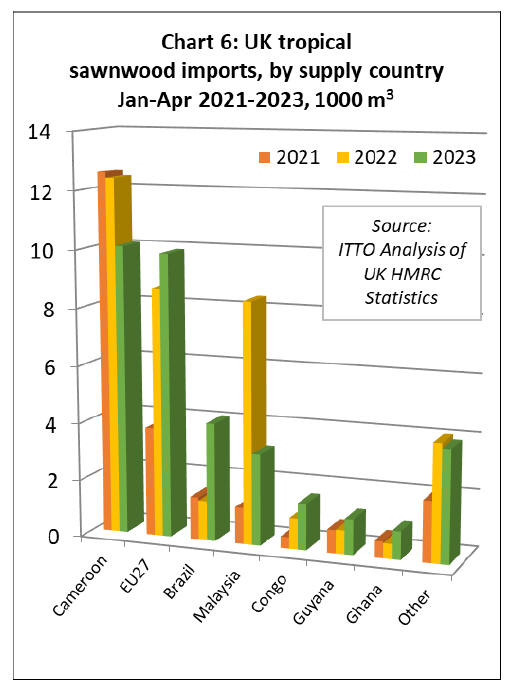
UK imports of tropical sawnwood from Cameroon were 10,000 cu.m in the
first four months of 2023, 19% less than the relatively high level in
the same period in 2022. UK tropical sawnwood imports from Malaysia,
which revived to some extent last year after many years of decline, fell
by 62% in the first four months of this year to 3,200 cu.m.
UK imports of tropical sawnwood from Brazil were reported as 4,100 cu.m
in the first four months of this year, a gain of 199% compared to the
same period in 2022. UK tropical sawnwood imports also increased in the
first four months this year from Republic of Congo (+50% to 1,600 cu.m),
Guyana (+50% to 1,200 cu.m), and Ghana (+90% to 1,000 cu.m)
Indirect UK imports of tropical sawnwood via the EU recovered more
ground despite the Brexit disruption, increasing 14% to 10,000 cu.m in
the first four months of 2023.
To some extent, UK’s continuing dependence on indirect imports of
tropical sawnwood from the EU is due to a shortage of kiln drying space
in African supply countries combined with lack of any hardwood kiln
dying capacity in the UK.
And with future market conditions now uncertain, reports of sufficient
landed stocks of sapele, the UK’s preferred tropical wood, on hand in
Europe, and in the face of long and uncertain timelines for shipping
from the main tropical supply countries, UK importers are choosing to
fill gaps in stocks as they arise by cross-trading with other importers.
Tropical hardwood mouldings/decking imports
UK imports of tropical hardwood mouldings/decking fell 37% in
the first four months of 2023 to 2,800 tonnes. This commodity group
benefited in the UK market during 2022 from shortages of non-tropical
products, particularly since the start of the war in Ukraine and
sanctions on Russian decking products that directly compete with
tropical decking.
However, with high stocks built up in the UK last year and much reduced
consumption, imports of tropical mouldings/decking have fallen away
again this year. Imports of 850 tonnes from Indonesia were 46% less than
the same period in 2022. Imports from Malaysia also totalled 850 tonnes,
in this case down 14% compared to the same period last year.

Imports of this commodity group from Brazil were recorded at less than 100
tonnes in the first four months of this year, 92% less than the same
period last year.
In contrast, imports increased 126% from the Netherlands to 126 tonnes,
while imports from Vietnam increased 6-fold to 150 tonnes from a very
small base (Chart 7).
|